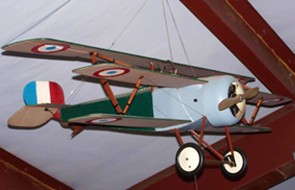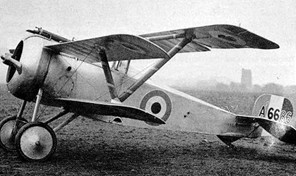
Gustave Delage, the main Nieuport designer, produced at least two triplane designs. The first appeared in 1915 and was a fairly unusual aircraft, but the more famous triplane, of 1916, was even stranger. On this aircraft the middle wing was furthest forward, attached to the front of the upper fuselage longerons, placing it level with the top of the fuselage. The lower wing was level with the bottom of the fuselage and was set back, with its trailing edge below the cockpit. The upper wing was the furthest back and was behind the cockpit. The idea was to improve the view of the pilot.

A triplane arrangement has a narrower wing chord than a biplane of similar span and area. This gives each wing-plane a slender appearance with higher aspect ratio, making it more efficient and giving increased lift. This potentially offers a faster rate of climb and tighter turning radius, both being important in a fighter aircraft. A triplane has reduced span compared to a biplane of given wing area and aspect ratio, leading to a more compact and lightweight structure. This potentially offers better maneuverability which is important for a fighter aircraft.
The airplane was powered by a 110 HP Le Rhone 9J engine and utilized a single synchronized Lewis gun. It was officially tested late in 1916, but the unusual configuration proved to offer poor handling and was not ordered.
Wingspan 26 feet 3.5 inches Length 19 feet 2.5 inches
Empty weight 919 pounds Maximum take-off weight 1,386 pounds
Source: Some excerpts from historyofwar.org/articles/weapons_nieuport_triplane
 Gustave Delage, the main Nieuport designer, produced at least two triplane designs. The first appeared in 1915 and was a fairly unusual aircraft, but the more famous triplane, of 1916, was even stranger. On this aircraft the middle wing was furthest forward, attached to the front of the upper fuselage longerons, placing it level with the top of the fuselage. The lower wing was level with the bottom of the fuselage and was set back, with its trailing edge below the cockpit. The upper wing was the furthest back and was behind the cockpit. The idea was to improve the view of the pilot.
Gustave Delage, the main Nieuport designer, produced at least two triplane designs. The first appeared in 1915 and was a fairly unusual aircraft, but the more famous triplane, of 1916, was even stranger. On this aircraft the middle wing was furthest forward, attached to the front of the upper fuselage longerons, placing it level with the top of the fuselage. The lower wing was level with the bottom of the fuselage and was set back, with its trailing edge below the cockpit. The upper wing was the furthest back and was behind the cockpit. The idea was to improve the view of the pilot.
 A triplane arrangement has a narrower wing chord than a biplane of similar span and area. This gives each wing-plane a slender appearance with higher aspect ratio, making it more efficient and giving increased lift. This potentially offers a faster rate of climb and tighter turning radius, both being important in a fighter aircraft. A triplane has reduced span compared to a biplane of given wing area and aspect ratio, leading to a more compact and lightweight structure. This potentially offers better maneuverability which is important for a fighter aircraft.
The airplane was powered by a 110 HP Le Rhone 9J engine and utilized a single synchronized Lewis gun. It was officially tested late in 1916, but the unusual configuration proved to offer poor handling and was not ordered.
Wingspan 26 feet 3.5 inches Length 19 feet 2.5 inches
Empty weight 919 pounds Maximum take-off weight 1,386 pounds
Source: Some excerpts from historyofwar.org/articles/weapons_nieuport_triplane
A triplane arrangement has a narrower wing chord than a biplane of similar span and area. This gives each wing-plane a slender appearance with higher aspect ratio, making it more efficient and giving increased lift. This potentially offers a faster rate of climb and tighter turning radius, both being important in a fighter aircraft. A triplane has reduced span compared to a biplane of given wing area and aspect ratio, leading to a more compact and lightweight structure. This potentially offers better maneuverability which is important for a fighter aircraft.
The airplane was powered by a 110 HP Le Rhone 9J engine and utilized a single synchronized Lewis gun. It was officially tested late in 1916, but the unusual configuration proved to offer poor handling and was not ordered.
Wingspan 26 feet 3.5 inches Length 19 feet 2.5 inches
Empty weight 919 pounds Maximum take-off weight 1,386 pounds
Source: Some excerpts from historyofwar.org/articles/weapons_nieuport_triplane
